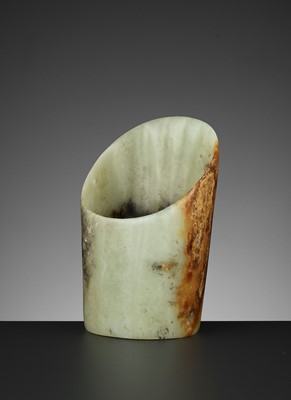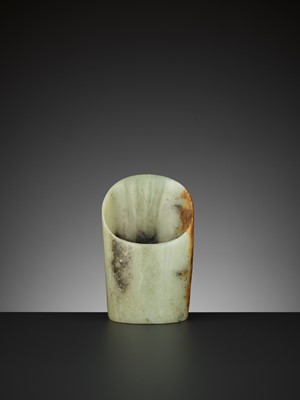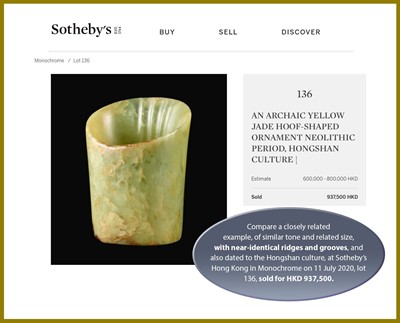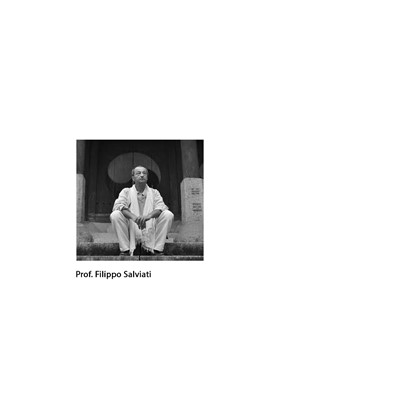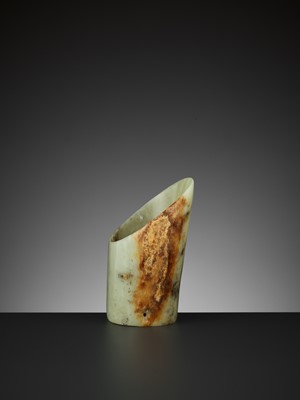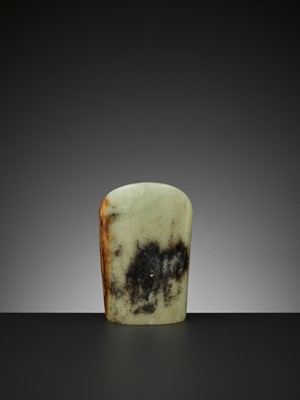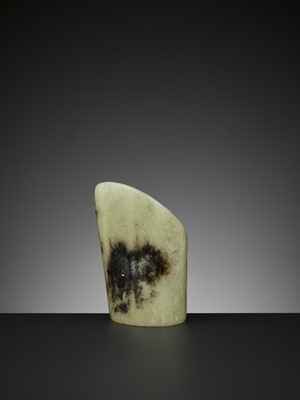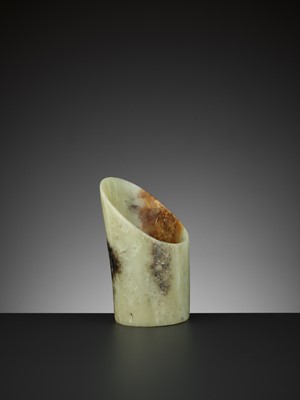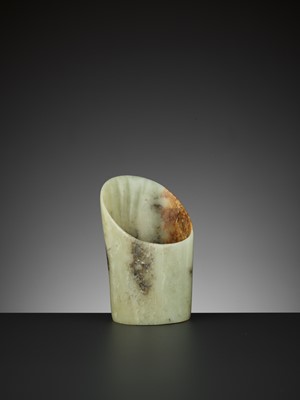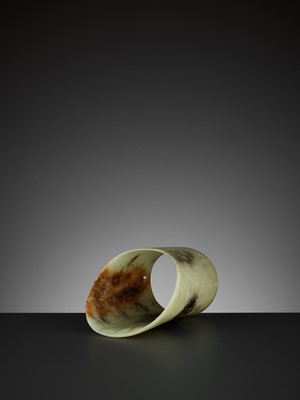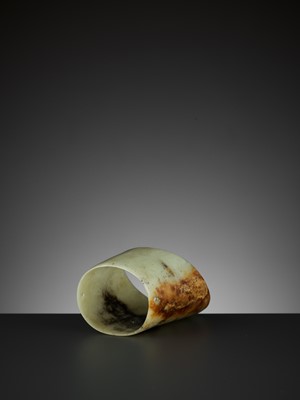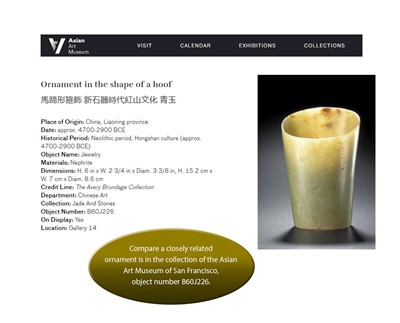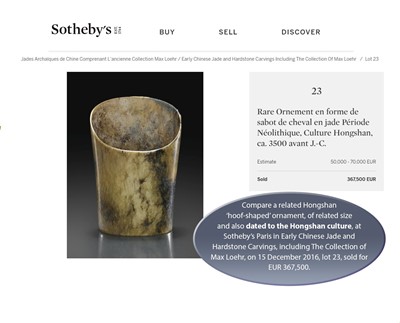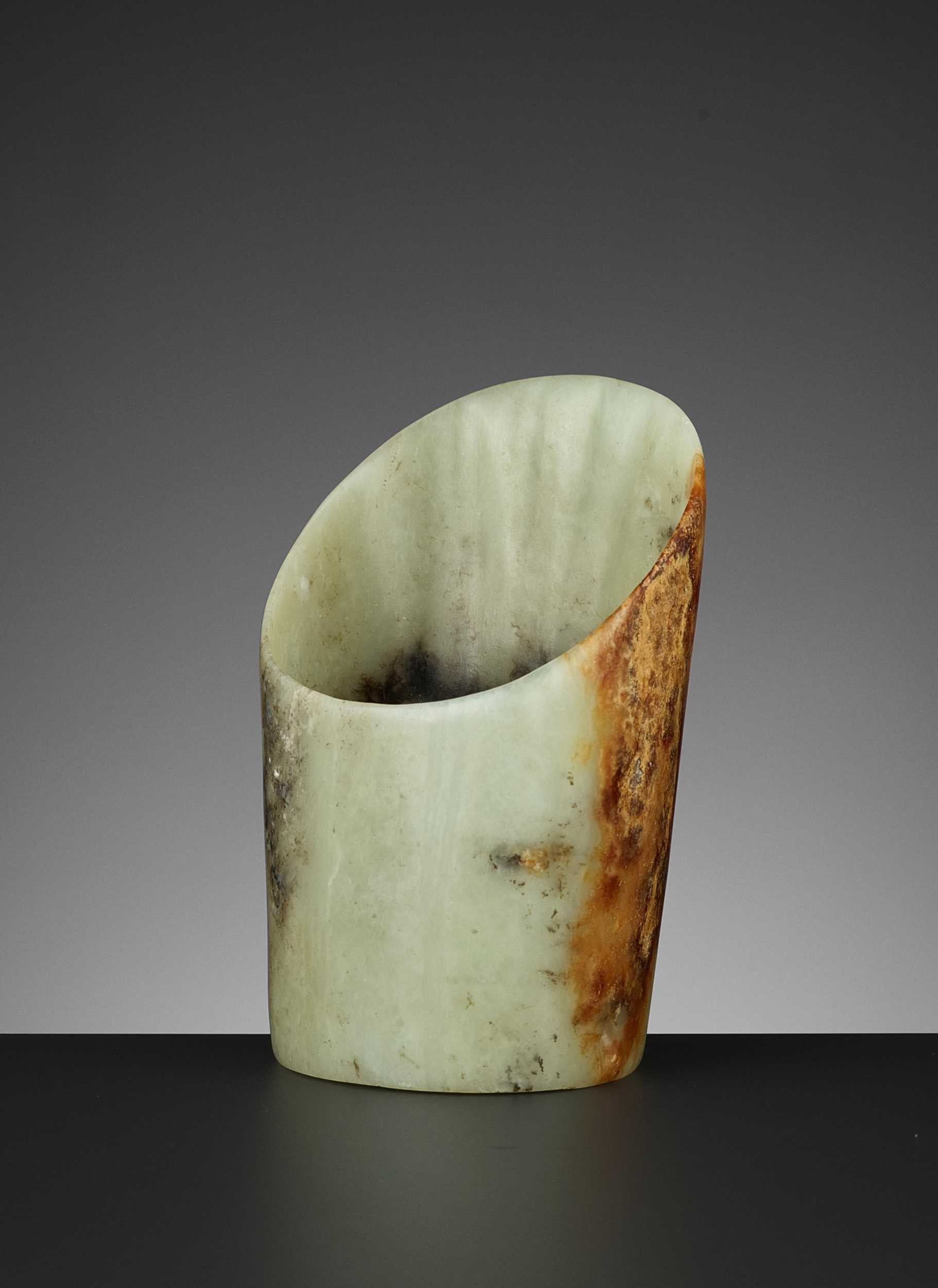15th Oct, 2021 10:00
TWO-DAY AUCTION - Fine Chinese Art / 中國藝術集珍 / Buddhism & Hinduism
60
A PALE YELLOW AND RUSSET JADE HOOF-SHAPED ORNAMENT, HONGSHAN
紅山文化褐斑青玉箍形器
Sold for €8,848
including Buyer's Premium
Jade. China, Hongshan culture, c. 4700-2900 BC. Delicately worked with tapered sides widening to a sloped upper edge, the interior of one side subtly detailed with linear ridges and grooves. Pierced with two small apertures. The translucent stone of a pale-yellow tone with shadings of black and russet with dark-brown veining and milky white inclusions, an opaque area within the russet shading.
Provenance: From the private collection of Professor Filippo Salviati, Rome, Italy. A professor of archeology and art history at the Italian Institute of Oriental Studies at the Sapienza University of Rome, Prof. Salviati has researched and published extensively on Chinese archaic art.
Condition: Excellent condition with minor wear, the stone with few natural fissures, some of which may have developed into small hairline cracks over time. The elongated opaque area within the russet shading indicates the exact resting position of this piece in the tomb from where it was excavated.
Large jade ornaments of this specific form were a product of the Hongshan culture, and examples have been recovered at the Niuheliang burial site in Liaoning province. While generally referred to as headpieces, Jenny F. So has recently suggested that they may have been worn on the forearm to protect the arm and wrist (Jenny F. So, Early Chinese Jades in the Harvard Art Museums, Cambridge, 2019, page 74). She cites an example worn on the forearm of the occupant of Site III at Niuheliang, and another recovered from the Bronze Age burial site at Dadianzi, in present-day inner Mongolia.
Weight: 211.0 g
Dimensions: Height 13.7 cm, Width 7.7 cm
Literature comparison: Compare with a similar ‘hoof-shaped’ tube ornament excavated at Niuheliang and exhibited in the National Museum of China, Beijing. A closely related ornament is in the collection of the Asian Art Museum of San Francisco, object number B60J226.
Auction result comparison: Compare a related Hongshan ‘hoof-shaped’ ornament, of related size and also dated to the Hongshan culture, at Sotheby’s Paris in Early Chinese Jade and Hardstone Carvings, including The Collection of Max Loehr, on 15 December 2016, lot 23, sold for EUR 367,500, and a closely related example, of similar tone and related size, with near-identical ridges and grooves, and also dated to the Hongshan culture, at Sotheby’s Hong Kong in Monochrome on 11 July 2020, lot 136, sold for HKD 937,500.
紅山文化褐斑青玉箍形器
中國,紅山文化,約公元前4700-2900 年。橢圓形玉器大口一端為斜口沿,另一端為相對稍小口,口部平整,内部有凹槽,穿有兩個小孔。半透明淺黃色,黑色和赤褐色斑,深棕色紋理和白色絮狀內含物,赤褐色陰影內局部不透明。
來源:義大利羅馬Filippo Salviati教授私人收藏。 Filippo Salviati教授是羅馬大學東亞研究所考古系及藝術史系教授。 Salviati教授對中國古代藝術進行了廣泛研究並出版了很多專著。
品相:品相極佳,輕微磨損,少量天然裂縫,隨著時間的推移,其中一些脈絡紋理可能會發展成細小的裂縫。 褐斑區域表明這件器具在出土墓中的確切安放位置。
這種形狀特殊大型玉器是紅山文化的產物,遼寧省牛河梁墓曾出土過。 雖然通常被認爲是頭飾,但 Jenny F. So 近年提出它們可能是戴在前臂上以保護手臂和手腕(Jenny F. So, Early Chinese Jades in the Harvard Art Museums, Cambridge, 2019, page 74)。 她舉了一個戴在牛河梁三號墓主前臂的例子,另一個是在今內蒙古大甸子青銅器時代墓地發現的。
重量:211.0 克
尺寸:高13.7 厘米, 寬 7.7 厘米
文獻比較:一件出土於牛河梁墓的箍形器可見於北京故宮博物院展覽。另一件可見於舊金山亞洲美術館,編號 B60J226。
拍賣結果比較:一件紅山文化箍形器,相近尺寸,見巴黎蘇富比 Early Chinese Jade and Hardstone Carvings,including The Collection of Max Loehr,2016年12月15日,lot 23,售價EUR 367,500;一件相似箍形器,帶有相似的玉色和尺寸,幾乎一模一樣的内壁和凹槽,同樣為紅山文化,見香港蘇富比Monochrome,2020年7月 11日,lot 136,售價HKD 937,500。
Jade. China, Hongshan culture, c. 4700-2900 BC. Delicately worked with tapered sides widening to a sloped upper edge, the interior of one side subtly detailed with linear ridges and grooves. Pierced with two small apertures. The translucent stone of a pale-yellow tone with shadings of black and russet with dark-brown veining and milky white inclusions, an opaque area within the russet shading.
Provenance: From the private collection of Professor Filippo Salviati, Rome, Italy. A professor of archeology and art history at the Italian Institute of Oriental Studies at the Sapienza University of Rome, Prof. Salviati has researched and published extensively on Chinese archaic art.
Condition: Excellent condition with minor wear, the stone with few natural fissures, some of which may have developed into small hairline cracks over time. The elongated opaque area within the russet shading indicates the exact resting position of this piece in the tomb from where it was excavated.
Large jade ornaments of this specific form were a product of the Hongshan culture, and examples have been recovered at the Niuheliang burial site in Liaoning province. While generally referred to as headpieces, Jenny F. So has recently suggested that they may have been worn on the forearm to protect the arm and wrist (Jenny F. So, Early Chinese Jades in the Harvard Art Museums, Cambridge, 2019, page 74). She cites an example worn on the forearm of the occupant of Site III at Niuheliang, and another recovered from the Bronze Age burial site at Dadianzi, in present-day inner Mongolia.
Weight: 211.0 g
Dimensions: Height 13.7 cm, Width 7.7 cm
Literature comparison: Compare with a similar ‘hoof-shaped’ tube ornament excavated at Niuheliang and exhibited in the National Museum of China, Beijing. A closely related ornament is in the collection of the Asian Art Museum of San Francisco, object number B60J226.
Auction result comparison: Compare a related Hongshan ‘hoof-shaped’ ornament, of related size and also dated to the Hongshan culture, at Sotheby’s Paris in Early Chinese Jade and Hardstone Carvings, including The Collection of Max Loehr, on 15 December 2016, lot 23, sold for EUR 367,500, and a closely related example, of similar tone and related size, with near-identical ridges and grooves, and also dated to the Hongshan culture, at Sotheby’s Hong Kong in Monochrome on 11 July 2020, lot 136, sold for HKD 937,500.
紅山文化褐斑青玉箍形器
中國,紅山文化,約公元前4700-2900 年。橢圓形玉器大口一端為斜口沿,另一端為相對稍小口,口部平整,内部有凹槽,穿有兩個小孔。半透明淺黃色,黑色和赤褐色斑,深棕色紋理和白色絮狀內含物,赤褐色陰影內局部不透明。
來源:義大利羅馬Filippo Salviati教授私人收藏。 Filippo Salviati教授是羅馬大學東亞研究所考古系及藝術史系教授。 Salviati教授對中國古代藝術進行了廣泛研究並出版了很多專著。
品相:品相極佳,輕微磨損,少量天然裂縫,隨著時間的推移,其中一些脈絡紋理可能會發展成細小的裂縫。 褐斑區域表明這件器具在出土墓中的確切安放位置。
這種形狀特殊大型玉器是紅山文化的產物,遼寧省牛河梁墓曾出土過。 雖然通常被認爲是頭飾,但 Jenny F. So 近年提出它們可能是戴在前臂上以保護手臂和手腕(Jenny F. So, Early Chinese Jades in the Harvard Art Museums, Cambridge, 2019, page 74)。 她舉了一個戴在牛河梁三號墓主前臂的例子,另一個是在今內蒙古大甸子青銅器時代墓地發現的。
重量:211.0 克
尺寸:高13.7 厘米, 寬 7.7 厘米
文獻比較:一件出土於牛河梁墓的箍形器可見於北京故宮博物院展覽。另一件可見於舊金山亞洲美術館,編號 B60J226。
拍賣結果比較:一件紅山文化箍形器,相近尺寸,見巴黎蘇富比 Early Chinese Jade and Hardstone Carvings,including The Collection of Max Loehr,2016年12月15日,lot 23,售價EUR 367,500;一件相似箍形器,帶有相似的玉色和尺寸,幾乎一模一樣的内壁和凹槽,同樣為紅山文化,見香港蘇富比Monochrome,2020年7月 11日,lot 136,售價HKD 937,500。
Zacke Live Online Bidding
Our online bidding platform makes it easier than ever to bid in our auctions! When you bid through our website, you can take advantage of our premium buyer's terms without incurring any additional online bidding surcharges.
To bid live online, you'll need to create an online account. Once your account is created and your identity is verified, you can register to bid in an auction up to 12 hours before the auction begins.
Intended Spend and Bid Limits
When you register to bid in an online auction, you will need to share your intended maximum spending budget for the auction. We will then review your intended spend and set a bid limit for you. Once you have pre-registered for a live online auction, you can see your intended spend and bid limit by going to 'Account Settings' and clicking on 'Live Bidding Registrations'.
Your bid limit will be the maximum amount you can bid during the auction. Your bid limit is for the hammer price and is not affected by the buyer’s premium and VAT. For example, if you have a bid limit of €1,000 and place two winning bids for €300 and €200, then you will only be able to bid €500 for the rest of the auction. If you try to place a bid that is higher than €500, you will not be able to do so.
Online Absentee and Telephone Bids
You can now leave absentee and telephone bids on our website!
Absentee Bidding
Once you've created an account and your identity is verified, you can leave your absentee bid directly on the lot page. We will contact you when your bids have been confirmed.
Telephone Bidding
Once you've created an account and your identity is verified, you can leave telephone bids online. We will contact you when your bids have been confirmed.
Classic Absentee and Telephone Bidding Form
You can still submit absentee and telephone bids by email or fax if you prefer. Simply fill out the Absentee Bidding/Telephone bidding form and return it to us by email at office@zacke.at or by fax at +43 (1) 532 04 52 20. You can download the PDF from our Upcoming Auctions page.
How-To Guides
How to Create Your Personal Zacke Account
How to Register to Bid on Zacke Live
How to Leave Absentee Bids Online
How to Leave Telephone Bids Online
中文版本的操作指南
创建新账号
注册Zacke Live在线直播竞拍(免平台费)
缺席投标和电话投标
Third-Party Bidding
We partner with best-in-class third-party partners to make it easy for you to bid online in the channel of your choice. Please note that if you bid with one of our third-party online partners, then there will be a live bidding surcharge on top of your final purchase price. You can find all of our fees here. Here's a full list of our third-party partners:
- 51 Bid Live
- EpaiLive
- ArtFoxLive
- Invaluable
- LiveAuctioneers
- the-saleroom
- lot-tissimo
- Drouot
Please note that we place different auctions on different platforms. For example, in general, we only place Chinese art auctions on 51 Bid Live.
Bidding in Person
You must register to bid in person and will be assigned a paddle at the auction. Please contact us at office@zacke.at or +43 (1) 532 04 52 for the latest local health and safety guidelines.
